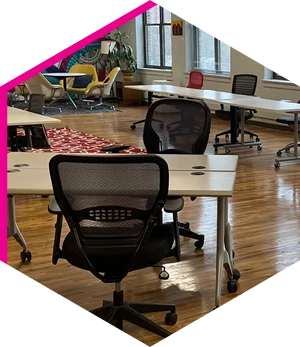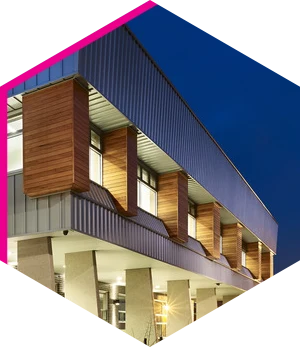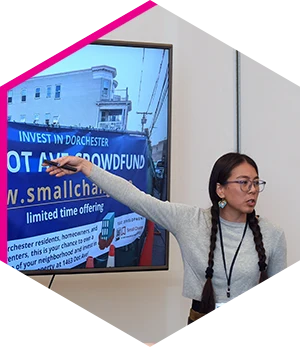Our mission is to increase the capacity and effectiveness of the nonprofit sector and improve the communities they serve by supporting the development and operations of quality community serving spaces.
We often customize our engagements to suit particular goals of our clients but the majority of our consulting work includes most, if not all, of the following steps. Want to learn more about consulting? Fill out the consulting intake form and an NCN staff member will contact you.

Assessing Project Readiness
Before taking on a lengthy and resource-dependent project what factors should your organization consider? Are staff and board aligned in the initial vision? Does the project support your existing mission? Do you have sufficient assets to cover pre-development costs? Is there internal real estate expertise at the board and staff level? Will this venture compete with other goals and fundraising efforts of the organization? How will the project affect how your organization is perceived? Which key partners need to be engaged in the process at the start?

Landscape Analysis
What are the needs in your community that you wish to address and how can they be demonstrated? Identify existing needs studies and create methods to better understand and demonstrate gaps in resources in your community. Identifying and characterizing existing resources supporting your work is a key component to understanding the issues you are addressing. What are the existing physical and other resources that overlap with your work? This step strengthens the case for your work by showing that you have a robust understanding of the landscape in which you’re working as well as the strengths and weaknesses of your approach.

Creating a Vision and & Consensus Building
Identifying key stakeholders and engaging them throughout the process will be critical to the success of the project. Build momentum for the project by creating a shared vision addressing specific needs of the participant organizations and the community. Potential stakeholders can include representatives from key building users, lead organization staff and board members, local philanthropy, public officials and/or community members at large. Consider comparable models of shared space to help provide clarity around the purpose for the space & programming of the building that will inform the schematic design of the project. How does your vision promote racial and economic diversity, equity and inclusion?

Understanding Need & Demand
Using the established vision for the community space program, start to build the case for your project by using quantitative and qualitative nonprofit needs assessment with potential or existing partners to assess interest, need, and ability to financially participate. These data will quantify demand, name key challenges or barriers to participation, and help you understand what affordability means to potential building users. Leverage existing community needs assessments and other tools and understand existing resources and how your project fills a gap in those resources. Showing demonstrable community need and willingness to participate will be critical to building your case for philanthropic and other financial support.

Financial Modeling
Understanding and documenting the financial sustainability of your project is a fundamental requirement for moving forward. Based on the scale of demand for space, what is the ideal size for your project. Rely on local market conditions to determine likely costs for development; either renovating an existing building or ground up development. Consider what sustainable operations look like. What operating costs are affordable to your organization and to potential tenants? What staffing will be required to catalyze collaboration among different organizations in the building? Determining what sustainable operations look like will inform requirements of your development sources including how much debt financing the project might support.

Financing Strategies
How your project is funded will depend on many factors. Identifying potential sources of funding and understanding how those sources might impact one another is an important step to understanding feasibility. Typical social purpose real estate projects have complex capital stacks with 5 or more sources. These might include, owner equity, private and corporate donations, New Markets and Historic Tax Credits, mission related investments, government grants, bond financing and traditional debt. Once you begin to identify and secure commitments for your sources you will develop an understanding of what gaps in funding you might be facing. Coordinating the timing for different sources will be an important consideration.

Developing the Case for Support
Funders, lenders and other partners want to participate in projects that are thought out, feasible, have strong support and demonstrate their impact. Synthesizing all of the pieces of the work completed in the previous phases of the process and presenting them in a compelling narrative is the next step. This means building a story around the vision of the project and presenting the qualitative and quantitative data as evidence of demand, feasibility and future success. The case statement may be further refined by fundraising and design professionals.

Building and Managing a Development Team
In addition to some amount of in-house real estate experience, development projects require expertise from multiple professional fields. The particular components of your project will determine which experts you will need to bring onto your team. In many cases a minimum team of an architect, attorney and builder will be required. More complicated projects may also enlist the services of a planner, developer, multiple engineers, brokers, finance consultants. Finding values-aligned team members should be prioritized and done thoughtfully through a RFQ / RFP process. Financing partners including lenders and tax credit specialists should be a part of this process to test feasibility and understand likely terms and conditions of financing.

Site Selection and Control
Needs and demand analyses should help determine the approximate location of your project. Other considerations for site location include access to public transportation or a central location with adequate parking, proximity to other services and facilities proximate to your work, appropriate land use restrictions and availability of development incentives such as tax credits. Organizations without the infrastructure to execute real estate transactions quickly are at a disadvantage compared to private equity-backed developers. Positioning yourself to react quickly to the market and to take advantage of resources that may be aligned with your mission will be important to your success.

Design Considerations
Shared spaces are distinct in their requirements compared to other workspaces or even other public buildings. Finding design professionals that are open to understanding these requirements will be important. So too will be an intentional investigation of other, similar facilities and developing an understanding of the operational consequences of certain design decisions. Some considerations include safety and security of resident organizations and the public, accessibility, multiple types of use, change of use depending on time of day or week or season and designing for flexibility of use depending on program changes over time. Furnishings, audio visual equipment and scheduling systems will also impact success of the space.

Governance and Decision Making
There are multiple ways to own and govern property. Consider models that others have put into place that suit the mission of your facility. Corporate structures can include an LLC, stand-alone non-profit or a supporting non-profit. Ownership can be vested in one organization or jointly though a percentage stake or via condominium divisions. Long-term considerations and stewardship can be vested in a third-party asset manager. Day to day operations can be overseen by a property manager. Beyond operating the facility how will tenant and building-related programming be determined? A tenant council can be established to determine policies that affect the user and public experience in the building while being isolated from the risk and responsibility of facilities management.

Operations Planning
What are lease and license terms that are mission aligned but mitigate risks of being a landlord? Develop job descriptions for key personnel that ensure your values are exemplified in those roles. Consider safety measures and how they impact users and visitors of the building. How do you find mission-aligned vendors especially those with on-site staff. Create policies for building use that support your mission, empower the users of the building, support the needs of neighbors and visitors and promote diversity, equity and inclusion.
